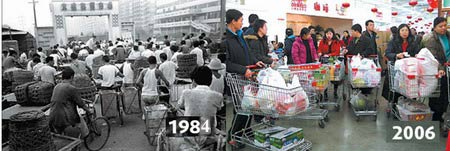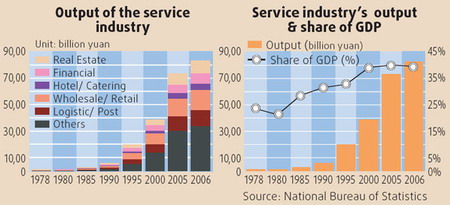|
|
 |
|
30th Anniversary Celebrations
Economic Development
New Rural Reform Efforts
Political System Reform
Changing Lifestyle
In Foreigners' Eyes
Commentary
Enterprise Stories
Newsmakers
Photo Gallery
Video and Audio
Wang Wenlan Gallery
Slideshow
Key Meetings
Key Reform Theories
Development Blueprint
Li Xing:
Teachers like Li need our support Alexis Hooi:
Going green in tough times Hong Liang:
Bold plan best option for economy Market growth
By You Nuo (China Daily)
Updated: 2008-05-05 17:14
  This was the beginning of an ordinary day in Beijing in 1984 when private vendors and their logistical contractors (those pushing tricycles) were ready to enter a market before it was open to customers. At the time, one phenomenon in all urban residential quarters in China was the so-called emerging "free markets" - a name that might sound too grand or philosophical to be a place where you could spend half a yuan to buy some fresh spinach or a pancake. People from other countries would simply call it a neighborhood market, grocery or bazaar. The name did sound much more significant than the immediate reality - a shabby, often unsheltered, marketplace which generated a total of several hundred yuan worth of daily sales for all vendors. It would not be generating much more considering how much all the tricycles could move in sacks and baskets. Small and makeshift as these businesses were, however, their very existence had been unlikely just a few years ago. Individuals trading items for a profit, especially without approval from administrative officials at a certain level of administration, would be subject to public criticism and reprimands, if not criminal charges. Through the most outrageous years of the 1960s and 70s, going for "free market" was regarded as a daring challenge to the notion of the "planned economy". The latter was deemed to be "purer" than the former. So when economic reforms began, no attempts were made to make the economic system "pure" by any ideological standard and people triumphantly called where they would gather and trade a "free market". Much of China today is a result of such changes that seemed as small as the sacks and baskets of the 1980s. That is why today's mammoth flourishing economy owes a debt to the old grass-roots "free market". Dominating the landscape of urban retail business, like in many other countries, are the supermarkets and glittering department stores. In a shopping mall like the one in the color picture - the first Wal-Mart in Beijing - an individual shopper's single bill could exceed the total revenue of a "free market" of the 1980s. In fact, from the beginning of its market-oriented reform to the middle of the 2000s, China's retail business (in terms of retail sales of consumer goods) saw a growth of 49-fold. The nation's total retail volume was 155.8 billion yuan ($22.68 billion) in 1978, as compared with 7.64 trillion yuan in 2006. Also in 2006, the retail industry alone, not including hospitality and catering, created at least 3.1 million jobs. But when combined, the three industries amounted to more than 8.5 million jobs.

 
 |
主站蜘蛛池模板: 中文字幕一区二区三区视频在线 | 99在线观看巨臀大臀视频 | 欧美高清一区二区三 | 欧洲亚洲一区二区三区 | 国产成人亚洲精品91专区高清 | 久久国产热视频 | 欧美成年视频 | 欧美xxx高清 | 黄页美女| 在线观看亚洲 | 久久精品免费一区二区视 | 性8sex亚洲区入口 | 国产又色又爽黄的网站免费 | 日本三级欧美三级 | 欧美视频一区二区在线观看 | 99国产精品久久久久久久成人热 | 国产成人精品免费视频大全可播放的 | 久久免费视频播放 | 久久九九国产精品怡红院 | 玖玖精品在线视频 | 一级做a爰片久久毛片免费看 | 精品国产91久久久久 | 亚洲3级| 国产亚洲欧美成人久久片 | 亚洲欧美自拍一区 | 成年人看的毛片 | 国产三级小视频在线观看 | 亚洲专区一| 久久99久久精品免费思思 | 亚洲午夜精品一级在线 | 久久国产精品久久国产片 | 大香伊蕉国产短视频69 | 亚洲字幕 | 黄色片免费网址 | 99在线小视频 | 91久久线看在观草草青青 | 普通话对白国产情侣自啪 | 国产欧美日韩在线不卡第一页 | 国产成人久久精品区一区二区 | 亚洲成在线| 米奇777色狠狠8888影视 |